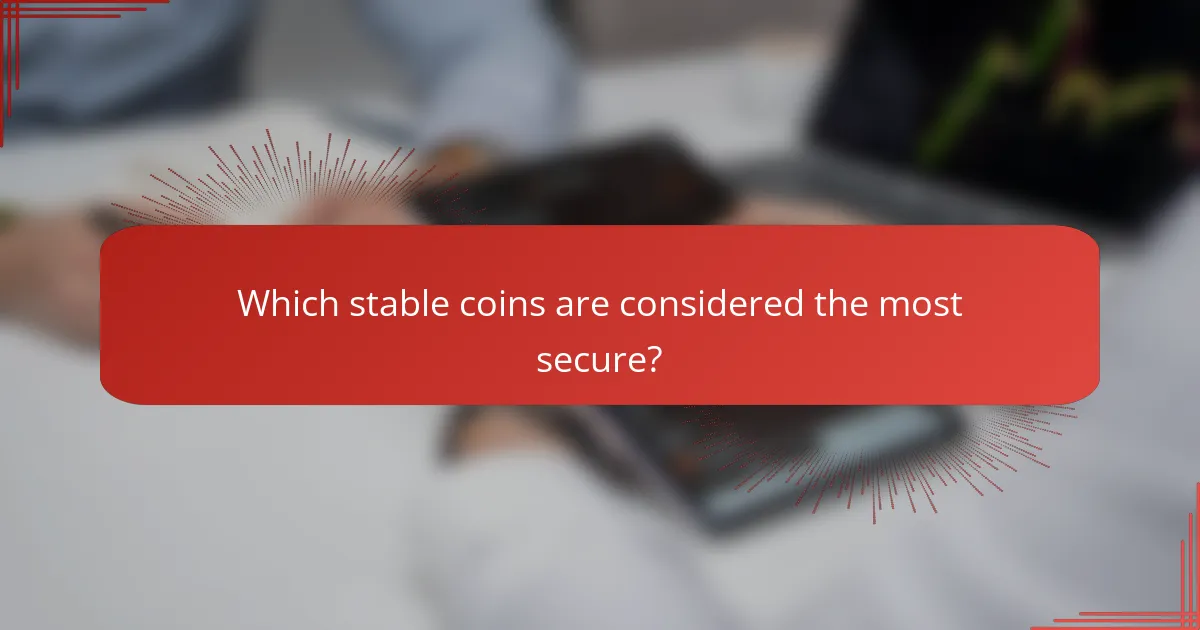Cryptocurrency stable coins provide notable security advantages that attract users and investors alike. By maintaining a stable value, often pegged to fiat currencies, they mitigate risks associated with price volatility, making them a safer option for digital transactions. Additionally, many stable coins are backed by reserves and comply with regulatory standards, further enhancing their reliability and trustworthiness in the market.

What are the security advantages of cryptocurrency stable coins?
Cryptocurrency stable coins offer several security advantages that make them appealing for users and investors. Their design aims to minimize risks associated with price fluctuations, enhance regulatory compliance, and ensure the safety of funds through various mechanisms.
Price stability
Stable coins are pegged to stable assets, such as fiat currencies like the US Dollar or Euro, which helps maintain their value. This price stability reduces the risk of sudden losses that can occur with more volatile cryptocurrencies. For example, a stable coin pegged to the USD will typically trade around $1, providing a reliable medium of exchange.
Reduced volatility
By design, stable coins experience significantly lower volatility compared to traditional cryptocurrencies. This reduced volatility makes them a safer option for transactions and savings, as users can avoid the erratic price swings that characterize assets like Bitcoin or Ethereum. Investors often use stable coins to hedge against market fluctuations.
Regulatory compliance
Many stable coins are developed with regulatory compliance in mind, which enhances their security and legitimacy. They often adhere to financial regulations and undergo regular audits to ensure transparency. This compliance can help protect users from fraud and promote trust in the cryptocurrency ecosystem.
Smart contract security
Stable coins frequently utilize smart contracts to manage transactions and maintain their peg to underlying assets. These smart contracts are programmed to operate under specific conditions, reducing the risk of human error and enhancing security. However, users should still be aware of potential vulnerabilities in smart contracts and choose stable coins with a strong security track record.
Backing by reserves
Most reputable stable coins are backed by reserves of fiat currency or other assets, which provide a safety net for their value. This backing ensures that for every stable coin issued, there is a corresponding asset held in reserve, typically in a bank account or with a custodian. Users should verify the reserve policies of stable coins to ensure their funds are adequately protected.

How do stable coins compare to traditional cryptocurrencies?
Stable coins are designed to maintain a stable value, often pegged to a fiat currency, unlike traditional cryptocurrencies that can experience significant volatility. This stability makes stable coins an attractive option for users seeking to mitigate risk while engaging in digital transactions.
Lower risk profile
Stable coins typically have a lower risk profile compared to traditional cryptocurrencies due to their value being pegged to stable assets like the US dollar or euro. This [censured] reduces the likelihood of drastic price fluctuations, making them a safer choice for investors and users.
For example, while Bitcoin and Ethereum can experience swings of 10% or more in a single day, stable coins like Tether (USDT) or USD Coin (USDC) generally maintain their value within a narrow range, often less than 1% deviation from their pegged currency.
Predictable value
The predictable value of stable coins allows users to plan their transactions and investments with greater confidence. This predictability is essential for businesses that need to manage cash flow and pricing strategies without the uncertainty associated with traditional cryptocurrencies.
For instance, a business accepting payments in stable coins can set prices in a stable currency equivalent, ensuring that revenue remains consistent regardless of market volatility in the broader cryptocurrency space.
Use cases in commerce
Stable coins have become increasingly popular in commerce, particularly for cross-border transactions and remittances. Their stable value allows businesses to transact without the fear of losing money due to sudden price changes.
Additionally, many online platforms and exchanges now accept stable coins for payments, making them a practical option for everyday purchases. This trend is particularly evident in regions with unstable local currencies, where stable coins provide a reliable alternative for consumers and merchants alike.

Which stable coins are considered the most secure?
The most secure stable coins typically include USDC, DAI, and Tether (USDT). These coins are backed by reserves and adhere to regulatory standards, which enhances their stability and trustworthiness in the cryptocurrency market.
USDC
USDC, or USD Coin, is a fully-backed stable coin pegged to the US dollar. It is issued by regulated financial institutions and undergoes regular audits to ensure transparency and security of its reserves.
One key advantage of USDC is its compliance with US regulations, making it a preferred choice for users seeking a secure and trustworthy stable coin. Its backing by actual US dollars held in reserve provides a strong safety net against volatility.
DAI
DAI is a decentralized stable coin that maintains its value through a system of smart contracts on the Ethereum blockchain. Unlike USDC, DAI is not directly backed by fiat currency but rather by collateralized assets, primarily Ethereum.
This decentralized nature allows DAI to operate without a central authority, which can be appealing for users who prioritize privacy and autonomy. However, it also means that DAI’s stability relies on the value of its collateral, which can fluctuate significantly.
Tether (USDT)
Tether (USDT) is one of the most widely used stable coins, pegged to the US dollar. It claims to be backed by reserves that include cash and cash equivalents, although its transparency regarding these reserves has faced scrutiny.
Despite concerns, USDT remains popular due to its liquidity and integration across numerous exchanges. Users should be aware of the potential risks associated with Tether’s backing and consider diversifying their stable coin holdings for added security.

What are the potential risks of using stable coins?
Stable coins, while designed to maintain a stable value, carry several risks that users should be aware of. These include regulatory scrutiny, counterparty risk, and technical vulnerabilities that can affect their reliability and security.
Regulatory scrutiny
Stable coins often face intense regulatory scrutiny due to their potential impact on financial systems and consumer protection. Governments and financial authorities are increasingly concerned about issues such as money laundering, fraud, and the lack of consumer safeguards.
In many jurisdictions, stable coin issuers may need to comply with existing financial regulations, which can vary significantly. For instance, in the European Union, the Markets in Crypto-Assets (MiCA) regulation aims to provide a comprehensive framework for the use of stable coins.
Counterparty risk
Counterparty risk refers to the possibility that the issuer of a stable coin may not be able to fulfill its obligations, such as redeeming coins for fiat currency. This risk is particularly relevant for fiat-backed stable coins, which rely on reserves held by the issuer.
To mitigate this risk, users should verify the transparency of the issuer’s reserves and whether regular audits are conducted. A stable coin backed by a reputable financial institution may offer more security compared to one from a lesser-known entity.
Technical vulnerabilities
Technical vulnerabilities can arise from flaws in the underlying blockchain technology or smart contracts that govern stable coins. These vulnerabilities may expose users to hacks or system failures, potentially leading to loss of funds.
To minimize exposure to these risks, users should choose stable coins that have undergone thorough security audits and have a proven track record. Staying informed about updates and potential security issues related to the stable coin can also help users protect their investments.

How can users ensure security when using stable coins?
Users can enhance security when using stable coins by selecting reliable platforms, implementing strong personal security measures, and staying informed about market risks. Employing best practices helps mitigate potential threats associated with digital currencies.
Choosing reputable exchanges
Selecting a reputable exchange is crucial for the security of your stable coin transactions. Look for exchanges that are well-established, have a strong track record, and are regulated by relevant authorities. User reviews and ratings can provide insights into the exchange’s reliability.
Consider exchanges that offer robust security features such as two-factor authentication (2FA), cold storage for funds, and insurance policies against breaches. Examples of reputable exchanges include Coinbase, Binance, and Kraken, which are known for their security measures and user-friendly interfaces.
Always verify the exchange’s compliance with local regulations, as this can indicate a commitment to security and consumer protection. For instance, exchanges operating in the European Union must adhere to the EU’s Anti-Money Laundering (AML) directives, enhancing their credibility.


